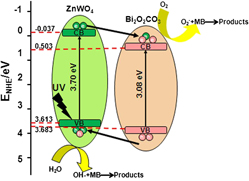Crossref Citations
This article has been cited by the following publications. This list is generated based on data provided by
Crossref.
Tian, Na
Huang, Hongwei
He, Ying
Guo, Yuxi
and
Zhang, Yihe
2014.
Novel g-C3N4/BiIO4heterojunction photocatalysts: synthesis, characterization and enhanced visible-light-responsive photocatalytic activity.
RSC Adv.,
Vol. 4,
Issue. 80,
p.
42716.
Tian, Na
Huang, Hongwei
Guo, Yuxi
He, Ying
and
Zhang, Yihe
2014.
A g-C3N4/Bi2O2CO3 composite with high visible-light-driven photocatalytic activity for rhodamine B degradation.
Applied Surface Science,
Vol. 322,
Issue. ,
p.
249.
Reshak, A.H.
Alahmed, Z.A.
and
Auluck, S.
2014.
A density functional study of the electronic properties of bismuth subcarbonate Bi2O2CO3.
Solid State Sciences,
Vol. 38,
Issue. ,
p.
138.
Duo, Fangfang
Fan, Caimei
Wang, Yawen
Cao, Yongqian
and
Zhang, Xiaochao
2015.
One-pot hydrothermal synthesis of a novel BiPO4/BiOBr composite with enhanced visible light photocatalytic activities.
Materials Science in Semiconductor Processing,
Vol. 38,
Issue. ,
p.
157.
Huang, Hongwei
Liu, Liyuan
Tian, Na
and
Zhang, Yihe
2015.
Structure, optical properties, and magnetism of Zn1−xNixWO4 (0⩽x⩽1) solid solution.
Journal of Alloys and Compounds,
Vol. 637,
Issue. ,
p.
471.
Keereeta, Yanee
Thongtem, Somchai
and
Thongtem, Titipun
2015.
Enhanced photocatalytic degradation of methylene blue by WO3/ZnWO4 composites synthesized by a combination of microwave-solvothermal method and incipient wetness procedure.
Powder Technology,
Vol. 284,
Issue. ,
p.
85.
Tian, Na
Huang, Hongwei
He, Ying
Guo, Yuxi
and
Zhang, Yihe
2015.
Organic–inorganic hybrid photocatalyst g-C3N4/Ag2CO3 with highly efficient visible-light-active photocatalytic activity.
Colloids and Surfaces A: Physicochemical and Engineering Aspects,
Vol. 467,
Issue. ,
p.
188.
Iyyapushpam, S.
Nishanthi, S.T.
and
Padiyan, D. Pathinettam
2015.
Synthesis of β-Bi2O3 towards the application of photocatalytic degradation of methyl orange and its instability.
Journal of Physics and Chemistry of Solids,
Vol. 81,
Issue. ,
p.
74.
Saravanamoorthy, Somasundaram
Chandra Bose, Arumugam
and
Velmathi, Sivan
2015.
Facile fabrication of polycaprolactone/h-MoO3 nanocomposites and their structural, optical and electrical properties.
RSC Advances,
Vol. 5,
Issue. 120,
p.
99074.
Gao, Yunxia
Huang, Yu
Li, Yan
Zhang, Qian
Cao, Jun-ji
Ho, Wingkei
and
Lee, Shun Cheng
2016.
Plasmonic Bi/ZnWO4 Microspheres with Improved Photocatalytic Activity on NO Removal under Visible Light.
ACS Sustainable Chemistry & Engineering,
Vol. 4,
Issue. 12,
p.
6912.
Wang, Meng
Fang, Minghao
Tang, Chao
Zhang, Lina
Huang, Zhaohui
Liu, Yan'gai
and
Wu, Xiaowen
2016.
A C3N4/Bi2WO6 organic–inorganic hybrid photocatalyst with a high visible-light-driven photocatalytic activity.
Journal of Materials Research,
Vol. 31,
Issue. 6,
p.
713.
Han, Shulei
Xiao, Ke
Liu, Liyuan
and
Huang, Hongwei
2016.
Zn1−xCoxWO4 (0≤x≤1) full range solid solution: Structure, optical properties, and magnetism.
Materials Research Bulletin,
Vol. 74,
Issue. ,
p.
436.
Kundu, Subrata
Ma, Lian
Chen, Yunyun
and
Liang, Hong
2017.
Microwave assisted swift synthesis of ZnWO 4 nanomaterials: material for enhanced photo-catalytic activity.
Journal of Photochemistry and Photobiology A: Chemistry,
Vol. 346,
Issue. ,
p.
249.
Ma, Jingjing
Tian, Li
Xu, Chao
Zhang, Yimeng
Zhang, Tao
Li, Hongxing
Zhao, Pengfei
Liang, Yaqiu
Wang, Jiwei
and
Fan, Xiaoxing
2018.
Hydrothermal Synthesis and Visible Light Photocatalytic Properties of Bi2O2CO3/Bi2WO6 Composite.
Catalysis Letters,
Vol. 148,
Issue. 1,
p.
41.
Anku, William W.
Oppong, Samuel O.B.
and
Govender, Penny P.
2018.
Bismuth - Advanced Applications and Defects Characterization.
Li, Min
Huang, Hongwei
Yu, Shixin
Tian, Na
and
Zhang, Yihe
2018.
Facet, Junction and Electric Field Engineering of Bismuth‐Based Materials for Photocatalysis.
ChemCatChem,
Vol. 10,
Issue. 20,
p.
4477.
Zhao, Jinyan
Yan, Xiaoming
Zhao, Ning
Li, Xiao
Lu, Bin
Zhang, Xuhong
and
Yu, Haitao
2018.
Cocatalyst designing: a binary noble-metal-free cocatalyst system consisting of ZnIn2S4 and In(OH)3 for efficient visible-light photocatalytic water splitting.
RSC Advances,
Vol. 8,
Issue. 9,
p.
4979.
Veldurthi, Naveen Kumar
Eswar, Neerugatti KrishnaRao
Singh, Satyapaul A.
and
Madras, Giridhar
2018.
Heterojunction ZnWO4/ZnFe2O4 composites with concerted effects and integrated properties for enhanced photocatalytic hydrogen evolution.
Catalysis Science & Technology,
Vol. 8,
Issue. 4,
p.
1083.
Zhang, Zuowei
Hao, Hongshun
Jin, Shanshan
Hou, Yunxia
Hou, Hongman
Zhang, Gongliang
Bi, Jingran
Yan, Shuang
Liu, Guishan
and
Gao, Wenyuan
2020.
Novel Tm3+/Yb3+–co-doped Bi2MoO6: Synthesis, characterization, and enhanced photocatalytic activity under visible-light irradiation.
Journal of Materials Research,
Vol. 35,
Issue. 3,
p.
312.
Yu, Wenying
Ji, Ning
Tian, Na
Bai, Liqi
Ou, Hongling
and
Huang, Hongwei
2020.
BiOI/Bi2O2[BO2(OH)] heterojunction with boosted photocatalytic degradation performance for diverse pollutants under visible light irradiation.
Colloids and Surfaces A: Physicochemical and Engineering Aspects,
Vol. 603,
Issue. ,
p.
125184.



